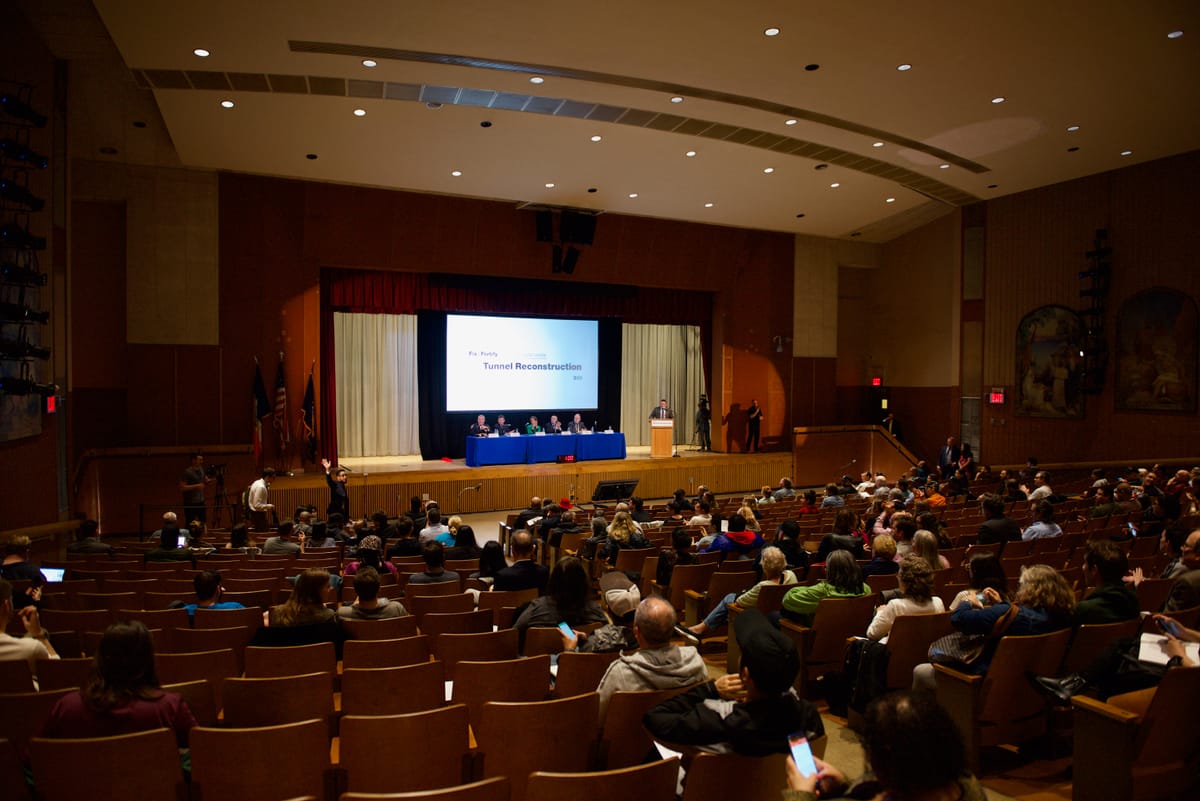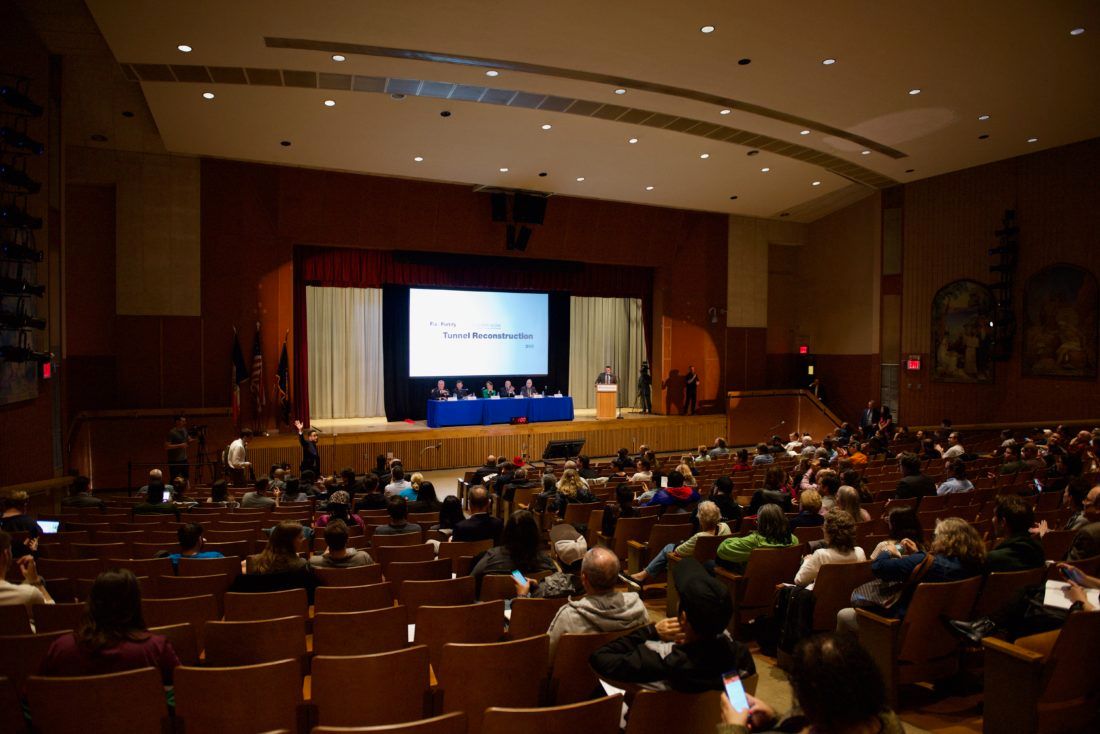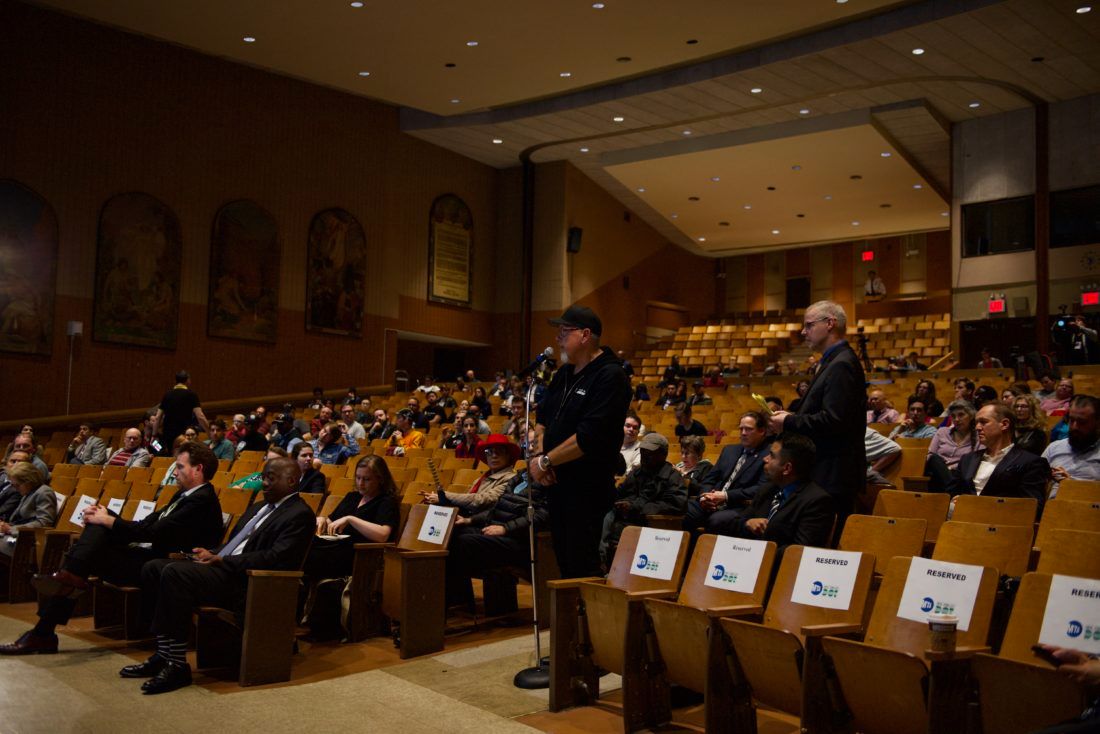Brooklyn Residents Seek Concrete Answers—And Find A Couple—At L Train Town Hall


WILLIAMSBURG – After last week’s contentious town hall in Manhattan on the L-train shutdown, hosted by the MTA and DOT, the Brooklyn edition, which took place last night in the auditorium of Progress High School in Williamsburg, was a relatively subdued affair.
In a large and half-full auditorium, NYC Transit Chief Andy Byford and DOT Commissioner Polly Trottenberg, flanked by members of the MTA and NYPD, gave a brief presentation to those who had braved the rain, then took questions from the audience on the status of plans for the coming L train shutdown, in which the Canarsie Tunnel will be repaired over the course of 15 months, starting in April 2019.
With the official plan still in limbo, Byford promised that definitive answers would be coming soon, emphasizing the organizations’ commitment to feedback. “We’ve been bending over backward to get input,” he said.
Following the open house meetings and these town halls, the final step will be presentations to community boards, before final plans are locked in. While much of the pertinent information has already been reported, some questions and takeaways from the talk were noteworthy:

Following a number of participants asking about 24-hour bus priority lanes over the Williamsburg Bridge, citing the L train’s tendency to stay crowded late into the night, Commissioner Trottenberg said it was clear that 24-hour priority is “one of the biggest pieces of the puzzle,” but cautioned that desires of Brooklyn-based riders must be tempered against the wants of those who live on 14th Street.
When asked to confirm whether a single fare would be accepted for transfers between the various parts of the system during the shutdown, be it subways, buses or ferries, Byford was quick to reply in the affirmative. His assent was a pleasant surprise for many in attendance, it seemed.
Of course, while looking at the final test—15 months of closure on the Canarsie Tunnel—perhaps not enough attention has been paid to the preceding events: namely, multiple weekend and overnight closures of surrounding stations that need to expand capacity to absorb displaced L train riders. Those closures will start as soon as this summer in preparation for the next phase of work.
A concern for many North Brooklyn residents, especially in light of the poor air quality already, is how many electric buses will be used during the shutdown. A pilot program is in place currently, testing the durability of electric buses, and Byford said that 15 were on order, with another 60 planned. However, the MTA plans to run 80 buses per hour across the Williamsburg Bridge during peak travel times—clearly, plenty of diesel buses will need to be employed.
The new ferry line, running from North 6th Street to Stuyvesant Cove, will be another option for passengers to cross the water. The MTA has boats on order much like those currently in use in the ferry system—with a capacity of 149 riders—but many speakers wanted higher capacity ferries. Byford acknowledged the request, but did politely shut down hopes of “intermodal” transit—namely, ferries that could carry buses—due to the narrow streets of Brooklyn leading up the waterfront.
There is some good news for G train riders, finding out that the four-car trains will be extended to 8 to 10 cars, and run more often during the shutdown. However, with 70% of the L train’s capacity expected to be absorbed by nearby lines, hopefully the changes will be enough to keep up with a boom in ridership. Not to mention the Village Voice, while crunching the numbers on JMZ changes, came up with some seriously disheartening math.
Many of the improvements in infrastructure being proposed for the shutdown have been couched as temporary changes: while it may be great to have protected bike lanes and more frequent trains, that doesn’t mean they’ll stick around once the project wraps up in 2020.
Commissioner Trottenberg, when asked about the temporary nature of improvements, said that each change in infrastructure would undergo a review process towards the end of the closure to see if they were worth continuing. Cyclists especially will be heartened to hear there’s a chance more protected bike lanes, especially on Grand Street, are here to stay.
With less than a year to go, most residents are still looking for a final plan to be released on the closure, and then possibly just hurrying up and getting it over with. Byford seems to agree, calling the shutdown one of the biggest challenges he’s faced in nearly 30 years of transit work.
“Most people get it,” he said, “It’s time to rip the Band-Aid off and get it done.”




